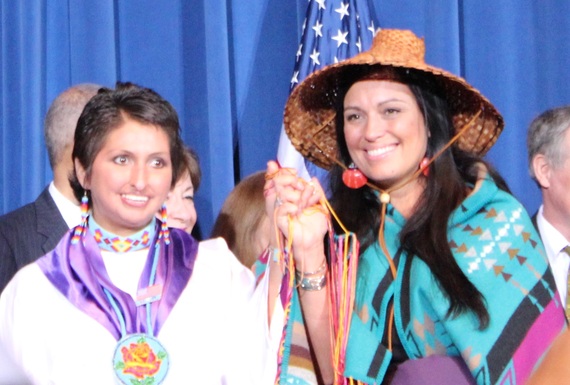Three years in D.C. have come and gone, and as I begin to embark on the next chapter of my life, there is one community and one calling that feels unfulfilled. You see, being a gender equality advocate in Washington D.C. is like nothing I have ever experienced. You are surrounded by strong voices for equality, a sometimes dizzying number of events to discuss and deliberate on, and a myriad of intersecting issues related to gender equality. Even with my strong foundation in women's studies, I am still shocked at the number of ways gender inequality can creep into almost every aspect of organized life. And there is the data to prove it. Whether it is AAUW's recent report, "Solving The Equation: Women in Computer Science and Engineering" or the recent launch of the "State of the World's Fathers Report" or several others, there is much work to be done and many thoughtful advocates undertaking it as we speak.
As this chapter of my life comes to a close, there is a still a number that I cannot forget. Statistically more than one in three Native American women will be raped over the course of their lives. A community with so many complex layered forms of trauma heaped upon it still experiences sexual violence higher than the rest of the country. Yet, the outcry that should be heard is absent at times. Now, that is not to say that there is not powerful and thoughtful work being done to advocate for the rights and safety of Native American communities. But in my attendance at hundreds of events, and in the countless hours of hearing experts speak, and seeing coalitions meet, the needs of this community still feel absent.
A time when the plight of Native American women was evident came during the most recent reauthorization of the Violence Against Women Act (VAWA). A key provision of that legislation provided tribal courts the authority to investigate and prosecute non-Native men who carry out abuse of Native women on tribal lands.
At the signing of the reauthorization of VAWA, an auditorium at the Department of the Interior was filled with Native women from every corner of the U.S. dressed in marvelous, colorful regalia. A spirit of relief seemed to have filled the room. While there was a long way to go, a very good step had been taken. I spoke after the event to the woman who introduced the Vice-President, and I stood humbled by her eloquence and courage in sharing her story of abuse and healing. In that space I felt welcome, seen and honored. I knew I needed to hear more of the stories carried by the attendees.
More than two years later, I was delighted to have the opportunity to meet LaDonna Harris again, founder of Americans for Indian Opportunity, at one of its events. I was invited by Pat Ruess, a longtime women's rights advocate and early champion of VAWA, who was to receive an award that night. I met individuals that, despite legacies of trauma, were carving a new path of hope. At the event, there was a raffle of crafts and goods from different areas around the U.S. One of them had chamomile tea from Alaska as a gift. While speaking to the woman who had won the package, I mentioned my love of chamomile tea -- a favorite with my grandfather. She then, without any hesitation, insisted I have it. I tried to fervently suggest she keep it. But to no avail. It was as though my keeping it was a greater gift for her. I've had similar experiences among Native communities across North America, whether at a potlach in Alert Bay, British Columbia or a Lakota sweat lodge in rural Georgia, I've seen a generosity unlike what society primes us to show. I don't intend to generalize an entire culture, and do realize the vast diversity and variety of virtues in each community, but this spirit of generosity, has been a beautiful constant in my experiences.
A longtime friend and mentor of mine, a woman with long sandalwood colored hair and warm brown eyes, used to tell me stories of how her parents met at a residential school in Montana. She recounted how her father, as a young boy, would tell her of long nights of crying in the school surrounded by other boys who were similarly stripped from their homes. And, perhaps, it was, in part, through hearing and understanding her family's past that a similar yet different memory of trauma that my family faced for being Bahá'ís in Iran was touched in me and will hopefully eventually be healed. Our stories, while miles apart, share so many of the same elements. They are evidence, in some sense, of our oneness.
Whether it is the statistic of 0.04% percent of the engineering workforce are Native American women , or the statistic of sexual violence faced by the Native American community cited above, this disheartening data seems bound by a silence reflective of the erasure of generations of history and culture that must be remembered, spoken of, and brought to light. And as the friend I describe above once told me, when I asked her how one knows what their destiny is, your destiny is bound together by what you choose to do, for that then becomes your destiny. So perhaps for us as a society, remembering, affirming and bearing witness to the trauma and possibility for healing for our Native American communities, and particularly the women and girls, is long overdue and not just possible, but inevitable.
Epilogue:
A moving short film that demonstrates living examples of resilience and healing in the Canadian First Nations community, and commissioned by the National Governing Body of the Bahá'ís of Canada, maybe found here:
https://vimeo.com/131765992
